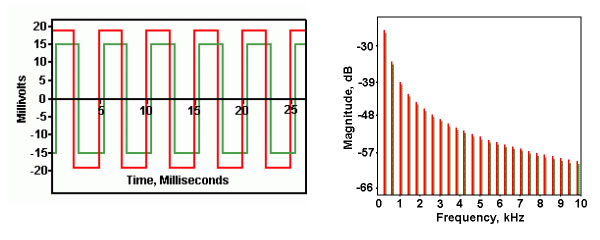Why is it important that a cable’s electrical properties don’t change over the audio frequency band? Let’s look at the simple case of a square wave. The plots on the left will be time signals, like one would view on an oscilloscope. A time-domain waveform can also be represented in the frequency domain. This field of study is known as Fourier analysis. The frequency plots will be shown on the right.
Here are the representations of a 200 Hz square wave:

If we pass this square wave through a perfect cable, we would get back all the frequency components exactly, which means we’d see exactly the same square wave, just delayed a bit in time, depending on the cable’s length. In the frequency domain, we’d see the same magnitudes as before. The only change would be in phase, which we’re not plotting.

If we passed the signal through a cable which attenuated the signal somewhat, but uniformly across the audio band, we would still see a square wave, but one which was reduced in amplitude. The essential character of the signal remains the same, it’s just not quite as loud. We could compensate for the difference from the perfect cable by simply increasing the amplification.

What happens when the attenuation is not uniform, but rather, varies with increasing frequency? We see that the shape of the time domain waveform is altered. For a simple square wave, we see that the shape is no longer square, but has corners that are rounded over. The essential nature of the time domain waveform is changed, and we can no longer recover the original signal by simply increasing the amplification.

How does this apply to the music we hear? A square wave has a very simple waveshape when compared to the complex signature of a musical passage. A piece of music is made up of a fundamental frequency plus a whole host of other frequencies, known as harmonics. It’s this harmonic content that allows us to distinguish one instrument from another, and to tell one person’s voice from another person’s.

Leave A Comment